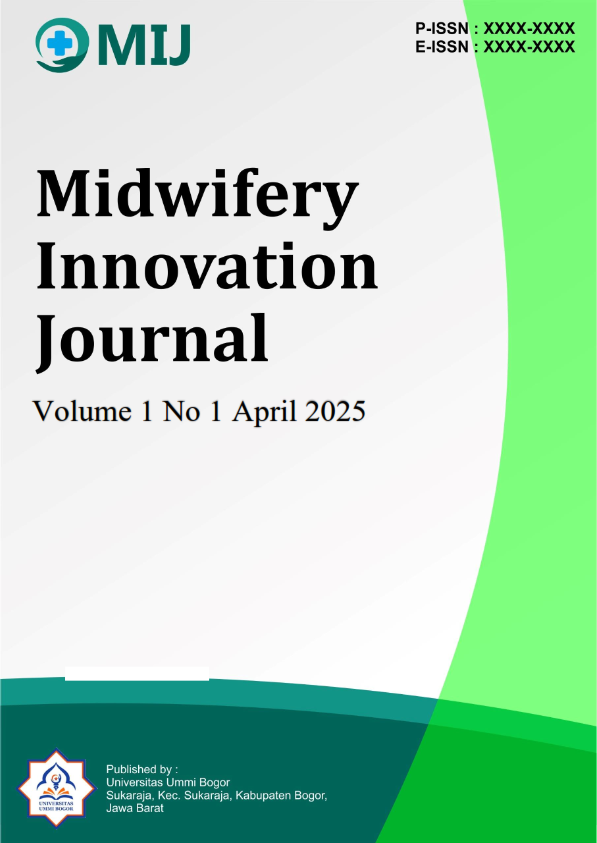Gambaran Karakteristik dan Pengetahuan Ibu Nifas Tentang Post Partum Blues di PMB M Kota Bogor Tahun 2024
Keywords:
Characteristics, Knowledge of Postpartum Mothers, Post Partum BluesAbstract
Background: Knowledge is obtained through sensing and learning, plays an important role in understanding health conditions such as baby blues. Baby blues is a mild mood disorder after childbirth that appears on the 3rd to 14th day, characterized by anxiety, crying, fatigue, and difficulty sleeping. The prevalence in Indonesia varies, with a study in PMB M obtained from 30 postpartum mothers, 23.3% of postpartum mothers have less knowledge. Research Objective: The purpose of this study was to determine the characteristics and knowledge of postpartum mothers about postpartum blues in PMB .M. Bogor City. Research Method: This study is a descriptive study with a cross-sectional design, involving 30 respondents taken through total sampling. Data were collected using a questionnaire and analyzed using univariate tests. Research Results: the majority of respondents were in the age range of 20-35 years 24 respondents (80%) and had a high school/vocational high school education level 21 respondents (70%). In terms of parity, most respondents were primipara 16 respondents (53.3%). In addition, the majority of respondents have good knowledge about Post Partum Blues 63.3%, while 23.3% have less knowledge, and 13.3% have sufficient knowledge. Conclusion: Knowledge about postpartum blues is mostly good in mothers aged 20–35 years, educated high school or college, and primipara. Age, education, and parity factors affect the level of knowledge.
References
A. Wawan, & Dewi, M. (2019). Teori dan pengukuran pengetahuan sikap dan perilaku manusia dilengkapi contoh kuesioner. Nuha Medika.
Al, S., et al. (2021). Gambaran kejadian postpartum blues pada ibu nifas berdasarkan karakteristik.
Andriani. (2019). Asuhan kebidanan post partum pada Ny. S 28 tahun P2A0 dengan perdarahan sisa plasenta di RSUD Sekarwangi. Asuhan Kebidanan Post Partum Pada Ny.S 28 Tahun P2A0 Dengan Perdarahan Sisa Plasenta Di RSUD Sekarwangi, 1(69), 5–24.
Anggrita Sari, D. (2021). Pengaruh tingkat pendidikan terhadap pengetahuan ibu nifas mengenai postpartum blues. 9(2), 356–363.
Anwar, & Safitri. (2022). Buku ajar asuhan kebidanan 3. Penerbit Media Sains Indonesia.
Dewi, & N. (2021). Gambaran perawatan ibu post partum. Buku Kebidanan, 4(1), 1–23.
Dwi Febriati, L., & Zakiyah, Z. (2022). Hubungan dukungan keluarga dengan adaptasi perubahan psikologi pada ibu hamil. Jurnal Kebidanan Indonesia, 13(1), 23–31. https://doi.org/10.36419/jki.v13i1.561
Ekadewi Retnosari, & Siti Fatimah. (2022). Prevalence and factors that contribute to baby blues syndrome on postpartum mothers. International Journal of Scientific and Professional (IJ- ChiProf), 1(2), 64–70. https://doi.org/10.56988/chiprof.v1i2.10
Eni. (2018). Faktor-faktor tingkat pengetahuan. Mi, 5–24.
Jayusman, I., & Shavab, O. A. K. (2020). Aktivitas belajar mahasiswa dengan menggunakan media pembelajaran Learning Management System (LMS) berbasis Edmodo dalam pembelajaran sejarah. Jurnal Artefak, 7(1), 13. https://doi.org/10.25157/ja.v7i1.3180
Kemenkes RI. (2021). Profil Kesehatan Indonesia Tahun 2020 (Vol. 48). IT - Information Technology. Kementerian Kesehatan Republik Indonesia.
Massalena, R. (2021). Gambaran karakteristik dan pengetahuan ibu nifas tentang postpartum blues. 1–23.
Natoatmodjo. (n.d.). Metode penelitian. Jakarta: Rineka Cipta.
Noviyana, Purwati & A. (2020). Faktor-faktor yang menyebabkan kejadian postpartum blues. Purwati Purwati, 10(2).
Nurul, A., Irma, H., & Sari, P. (2023). Hubungan kualitas tidur dengan postpartum blues di wilayah puskesmas Kabupaten Bogor tahun 2023. 1–10.
PNanda, P. S. W. (2019). Konsep dasar kunjungan masa nifas di wilayah kerja Puskesmas I Denpasar Selatan tahun 2022. Respiratory Poltekkes Denpasar, 9–25.
Sinabariba, M., Sinaga, D., Marsalena, R., Nifas, P. I., & Blues, P. P. (2022). Gambaran karakteristik dan pengetahuan ibu nifas tentang postpartum blues di Klinik Pratama SAM Kecamatan Medan Maimun Tahun 2021. 18–26.
Siti, D. (2020). Perkembangan dan konsep perkembangan anak usia dini. Jakarta: Universitas Terbuk.
Suparyanto, & Rosad. (2020). Perubahan masa nifas tahapan nifas. 5(3), 248–253.
Syapitri, H., Aritonang, J., & Press, A. (2021). Buku ajar metodologi penelitian kesehatan.
Tyarini, I. A., & Resmi, D. C. (2020). Pengaruh dukungan sosial orang terdekat dalam meminimalisir peristiwa dan dampak postpartum pada ibu usia muda. Jurnal Ilmiah Kesehatan, 10(1), 48–55.
Wahyuni, M. (2023). Tingkat pengetahuan terhadap DBD. 8–37.
Wakhidah, N. (2023). Faktor yang mempengaruhi postpartum blues di RS PKU Muhammadiyah Petanahan. Retrieved from https://repository.unimugo.ac.id/3206/%0Ahttps://repository.unimugo.ac.id/3206/1/NUR_WAKHIDAH_NIM.202206028_compressed.pdf
Wijaya, W., Limbong, T. O., & Yulianti, D. (2023). Buku ajar asuhan kebidanan nifas untuk sarjana akademik dan profesi. PT Nasya Expanding Management. https://www.academia.edu/107270568/Buku_Ajar_Asuhan_Kebidanan_Nifas
World Health Organization. (2020). WHO launches new tools to help countries address stillbirths, maternal, and neonatal deaths.
Yunitasari, E., & Suryani. (2020). Postpartum blues sebagai tinjauan literature. Jurnal Wellness and Healthy, 2(2), 303. https://wellness.journalpress.id/wellness





